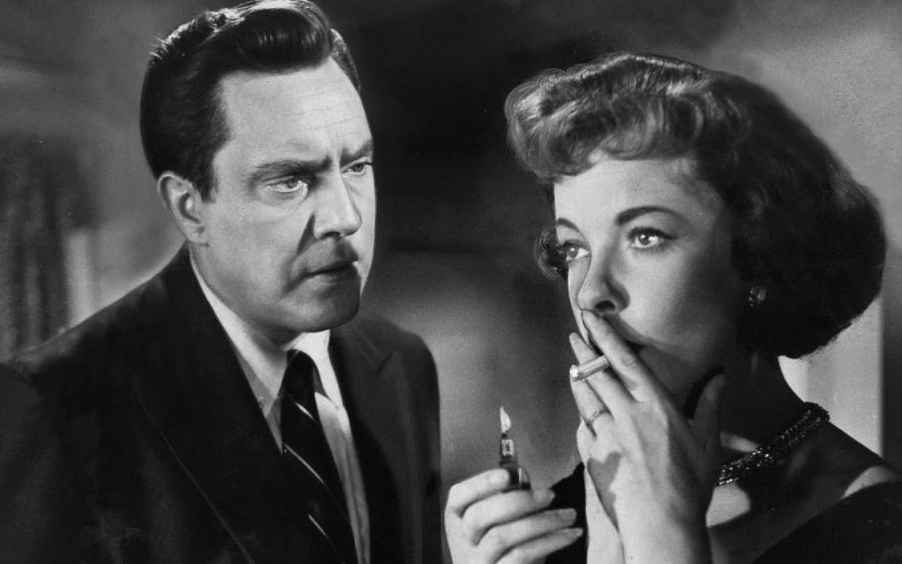It would not be inaccurate to describe film noir as a predominantly masculine genre, though it would be an oversimplification. These films feature men, but they are also about men–their anxieties, their insecurities, their fantasies. As narratives and characters are refracted through the cloudy perspectives of these hard-nosed, world-weary gumheels, a stark and affecting glimpse at the fractured milieu of postwar America emerges: a nation in sustained crisis, nervously reckoning with how suddenly it and the rest of the world have changed. Noirs hold immense value both as objects of historical scrutiny, and as elegiac, artful reflections on identity – especially male identity – lost.
In this regard, The Bigamist may seem like an aberration, not least because of the filmmaker behind it. Multi-hyphenate Ida Lupino began her career at a young age, playing bawdy bit parts on stage and screen before eventually receiving significant attention in the 1930s. She’d go on to act in a number of films by high-profile directors, including Raoul Walsh (They Live By Night, High Sierra), Michael Curtiz (The Sea Wolf), and Nicholas Ray (On Dangerous Ground), and alongside stars such as Humphrey Bogart, Robert Ryan, and John Garfield.
Lupino’s career blossomed further in 1948, when she and then-husband Collier Young formed The Filmakers, an independent company that aimed “to produce, direct, and write low-budget, issue-oriented films.” She made her debut behind the camera in 1949, co-directing and co-writing the wedlock drama Not Wanted. Her 1953 film The Hitch-Hiker was the first mainstream film noir directed by a woman. With The Bigamist, released later that same year, she became the first female filmmaker to both direct and star in a post-silent American feature. Despite the best efforts of the Production Code Administration – which, unsurprisingly, targeted Lupino with particular ferocity – the transgressive, confrontational subject matter of her work remained largely intact.
Genre classification can be a tricky thing, especially concerning film noir, which wasn’t properly identified as such by American scholars until the 70s (the term was originally coined in 1946 by French critic Nino Frank). Noir is more than a list of signifiers and aesthetics; it’s a philosophy, one of confusion, hopelessness, and decay, and it can be shaped to fit practically any narrative mold. Such a philosophy has, however, given rise to some broad commonalities. High-contrast chiaroscuro lighting, disjointed flashback structures, beautiful women uprooting the lives of troubled men–all share a close association with the genre, and all are present in The Bigamist.
But The Bigamist 1953 – which tells the story of a man clandestinely splitting his time between his two wives in northern and southern California, respectively – is far more idiosyncratic than these elements may suggest in isolation. The crime in question is born not of greed or lust, but of genuine affection. Protagonist Harry Graham (Edmund O’Brien), afflicted by grave loneliness in wake of his first wife’s newfound independence, finds himself falling utterly for another woman, and his desire to equally provide for them both leads to a long string of dilemmas that compound until he is undone fully.
There is often a tacit suggestion in film noir that the world has ossified: the systems bearing down on us are beyond comprehension and therefore beyond influence, inevitably infecting those who they do not kill outright. The Bigamist, though it paints a picture of a diseased society, stubbornly rejects despair. The evils present therein – infidelity and gendered conventions – surround the three central characters but do not corrupt them. Harry’s first wife, Eve (Joan Fontaine), is driven but emotionally distant, married more to her work than to him; his second wife, Phyllis (Ida Lupino), is a jaded waitress who spends her free time taking guided tours through the neighborhoods of wealthy Hollywood stars. The Bigamist 1953 takes these archetypes – the emasculated man, the industrious woman, the seductive vamp – and turns them on their head, rounding them out with nuance and pointed empathy. The characters navigate this world with an abiding hope that their situations can and will improve.
Given the film’s subject matter, this was (and is) a surprise. Infidelity, in American cinema and noir especially, has historically served as a jumping-off point for other, more heinous wrongdoings: extortion, murder, etc. The Bigamist, for a moment, leans into this presumption, fully aware of its own potential shock value. Aside from the provocative bluntness of its title, there’s initially an uncertainty about Harry, a lingering possibility that his apprehensive exterior masks something blemished and rotten, as with so many men in noir. But the film very soon rises above to challenge the legal boundaries that define “infidelity” to begin with, transcending its murky undertones and becoming a social problem picture as cutting and bold as any pre-code.
Though Harry ultimately fails to reconcile his love for both women with his innate fear of gender equality, The Bigamist’s coda insists that this phenomenon exists outside of a vacuum. Societal pressures drive men to absurd acts of self-sabotage, just as they create considerable obstacles for women striving toward their own goals (there is a metatextual profundity to Lupino gazing forlornly out of a bus window while the ornate mansions of Tinseltown’s finest whiz past). Bound as these characters are to moral codes, those codes are not static, nor are said characters unworthy of love. We are presented with the tantalizing possibility of both structural and individual change, and then the film ends, leaving us to assemble the pieces into whatever configuration proves most personally true.
The romantic turmoil behind The Bigamist’s production adds a crucial, revealing layer of context to its thesis. In 1951, Collier Young divorced Ida Lupino, and in 1952, he married Joan Fontaine. The Bigamist, which released in 1953, was directed by Lupino, written by Young, and featured Lupino and Fontaine as the male lead’s two (indirectly) competing love interests. Given these parallel entanglements, it would be all too easy to assume an incongruity between form and content, a chaotic marital spat given cinematic shape. But this is not so: the film is both written and directed with a deep respect for its subjects, with equal credence given to the inner struggles of O’Brien and Lupino’s characters. O’Brien, under Lupino’s direction, portrays Harry as an achingly passionate man unable to express the full immensity of his love. And Lupino, directing herself, is visibly weary but not without ambition, desiring consistency while recognizing that love is a messy, unpredictable venture. So it is in The Bigamist, and in the rest of her work–the work of an artist whose dual interests in the turbulence of relationships and the sociopolitical fault lines of postwar culture resulted in a cinema not of despondency, but of generous, resolute concern.
###
Ida Lupino’s The Bigamist (1953), starring Ida Lupino, Joan Fontaine, and Edmond O’Brien is now showing on Fandor.





